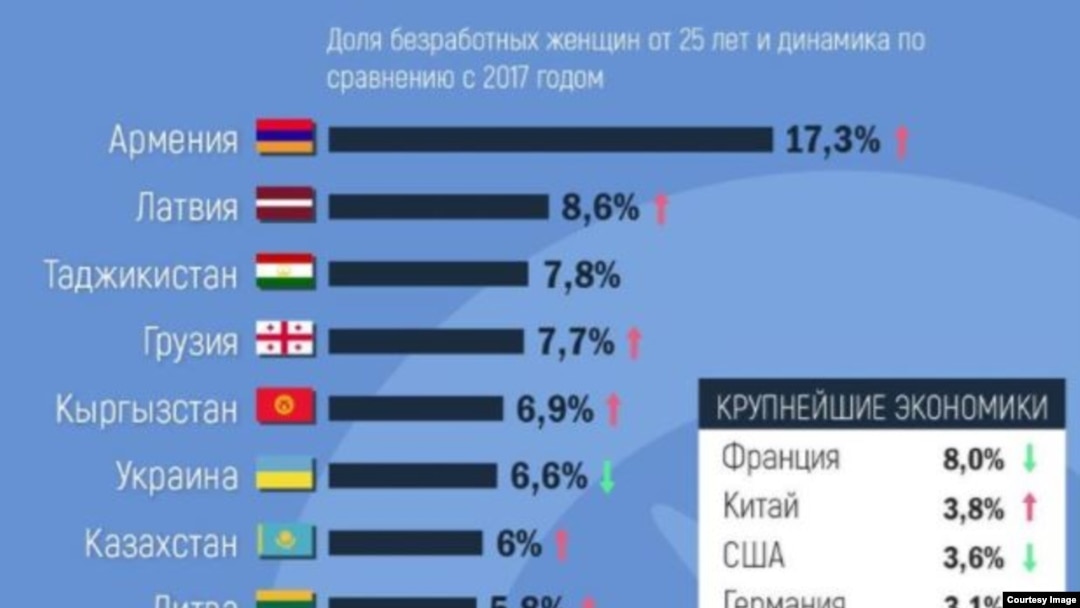According to the latest report of the International Labor Organization (ILO) published ahead of March 8, International Women’s Day, among post-Soviet countries Armenia has the highest unemployment rate among women.
Thus, according to the data, 17.3 percent of Armenian women aged above 25 are unable to find a job. For comparison, in Latvia, which is next country to Armenia in the report, only 8.6 percent of women face unemployment.
Unemployment among women in neighboring Georgia is 7.7 percent, while in Azerbaijan it is 4.8 percent.
According to the data released by the National Statistical Service of Armenia last year, there are 76,624 officially registered unemployed people in Armenia, of whom 50,593, i.e. more than 60 percent, are women.
“There is no appropriate environment that would promote the protection of women’s rights,” Ani Kojoyan, a lecturer at Yerevan State University (YSU), told RFE/RL’s Armenian service (Azatutyun.am).
She said that there is no problem with legislation, but there is a difference between being written on paper and applied. “In the case of women the employer may also take into account whether the potential candidate for a job is married or unmarried, whether she has a child or can have a child later that would require a maternity leave… I want to note that this also depends on women themselves. If women realize what rights they have and are not afraid to stand up for their rights at appropriate instances, it can be a good example for both the employer and other women,” she said.
Women not only experience more difficulty in getting jobs, but also receive lower salaries. Numerous studies in Armenia have shown that women’s average monthly salary is lower than men’s in all sectors of the economy, and this is in the case when women are not inferior to men in terms of education.
“Women often make more headway in the higher education system... But where do these women go in the future? When a woman does not immediately get a job, underestimation of her skills and abilities may actually take place. There are, in fact, many factors that contribute to this,” Kojoyan explained.
The United Nations also addressed the issue of inequality in women’s and men’s salaries in Armenia late last year. Authors of the 2017 report entitled “Worlds Apart: Reproductive Health and Rights in an Age of Inequality” asserted that many Armenian men demand that women have higher education, but later do not allow women to work.
Presenting the report, the then United Nations Population Fund (UNFPA) Armenia Assistant Representative Garik Hayrapetian insisted that the elimination of discrimination between women and men could have a positive impact on the country’s economic development. “You cannot leave 50 percent of the population out. Seven-nine percent of men have reported that they will not and do not allow their wives to work. If 7-9 percent [of women] do not work because of this, and I think that the percentage is much higher because this is a latent issue, Armenia has a burden of about $60 million on its GDP,” he said.
According to the ILO’s report, women’s unemployment rate worldwide is around 6 percent, which is higher than men’s unemployment rate by 0.8 percent.
The researchers note that the number of male employers is four times higher than the number of female employers and this tendency is also true for senior positions.
It is also noted that women agree more often than men to work without concluding a contract, bypassing the labor code and without joining trade unions.
According to YSU lecturer Kojoyan, the problem is also urgent for Armenia. “The State itself should be interested in developing mechanisms to ensure that women become taxpayers, because otherwise the State itself loses. On the other hand, if I look at it from a feminist perspective, this is first of all a violation of women’s rights, and programs should be aimed at raising the legal awareness of women, making them more demanding,” she said.


